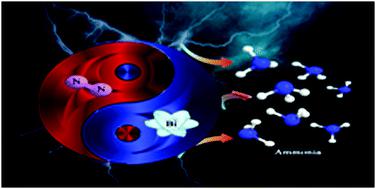当前位置:
X-MOL 学术
›
Mater. Horiz.
›
论文详情
Our official English website, www.x-mol.net, welcomes your
feedback! (Note: you will need to create a separate account there.)
Catalytic reduction of nitrogen to produce ammonia by bismuth-based catalysts: state of the art and future prospects
Materials Horizons ( IF 12.2 ) Pub Date : 2019-12-16 , DOI: 10.1039/c9mh01668f Qiang Hao 1, 2, 3, 4, 5 , Chuangwei Liu 6, 7, 8, 9 , Guohua Jia 5, 10, 11, 12 , Yuan Wang 4, 5, 13, 14 , Hamidreza Arandiyan 5, 15, 16, 17, 18 , Wei Wei 1, 2, 3, 4, 5 , Bing-Jie Ni 1, 2, 3, 4, 5
Materials Horizons ( IF 12.2 ) Pub Date : 2019-12-16 , DOI: 10.1039/c9mh01668f Qiang Hao 1, 2, 3, 4, 5 , Chuangwei Liu 6, 7, 8, 9 , Guohua Jia 5, 10, 11, 12 , Yuan Wang 4, 5, 13, 14 , Hamidreza Arandiyan 5, 15, 16, 17, 18 , Wei Wei 1, 2, 3, 4, 5 , Bing-Jie Ni 1, 2, 3, 4, 5
Affiliation

|
Ammonia is a key industrial raw material for fertilisers, chemicals and energy. The annual artificial ammonia synthesis via the Haber–Bosch process results in about 2% of global energy consumption and can lead to 1.6% CO2 emission. Hence, it is urgent to develop low-cost and environmentally friendly approaches for artificial ammonia synthesis under ambient conditions. Recently, bismuth (Bi)-based catalysts have attracted great interest due to their excellent nitrogen fixation performance in electrochemical and photocatalytic fields. However, there is still a lack of a comprehensive review on Bi-based nitrogen-fixation materials focusing on their crystal structure, surface engineering and modification methods, which is highly desirable for facilitating their further development towards applications. Herein, we provide an up-to-date review on Bi-based nitrogen-fixation materials and classify them as metallic Bi, bismuth oxide, bismuth oxyhalide, and Bi-based polyoxometalates. Starting from the underlying crystal structure, we analyse the internal electric field, surface engineering and modification methods of Bi-based nitrogen fixation materials. Then, we highlight the latest achievements of Bi-based materials and reveal the challenges and obstacles in the development and application of Bi-based nitrogen-fixation materials. More importantly, this review presents the surface and structure engineering strategies, and future directions for the development of new Bi-based nitrogen-fixation materials under ambient conditions.
中文翻译:

铋基催化剂催化还原氮以生产氨的技术和未来前景
氨是肥料,化学药品和能源的重要工业原料。通过哈伯-博世(Haber-Bosch)工艺进行的年度人工氨合成导致约2%的全球能源消耗,并可导致1.6%的CO 2排放。因此,迫切需要开发在环境条件下用于人造氨合成的低成本和环境友好的方法。近来,基于铋(Bi)的催化剂由于其在电化学和光催化领域中的优异的固氮性能而引起了极大的兴趣。然而,关于Bi基固氮材料的晶体结构,表面工程和改性方法仍然缺乏全面的综述,这对于促进其进一步的应用发展是非常需要的。在这里,我们提供有关Bi基固氮材料的最新综述,并将其分类为金属Bi,氧化铋,卤氧化铋和Bi基多金属氧酸盐。从下面的晶体结构开始,我们分析内部电场,Bi基固氮材料的表面工程和改性方法。然后,我们重点介绍了Bi基材料的最新成就,并揭示了Bi基固氮材料在开发和应用中所面临的挑战和障碍。更重要的是,本综述介绍了在环境条件下新型Bi基固氮材料的表面和结构工程策略以及未来的发展方向。
更新日期:2019-12-16
中文翻译:

铋基催化剂催化还原氮以生产氨的技术和未来前景
氨是肥料,化学药品和能源的重要工业原料。通过哈伯-博世(Haber-Bosch)工艺进行的年度人工氨合成导致约2%的全球能源消耗,并可导致1.6%的CO 2排放。因此,迫切需要开发在环境条件下用于人造氨合成的低成本和环境友好的方法。近来,基于铋(Bi)的催化剂由于其在电化学和光催化领域中的优异的固氮性能而引起了极大的兴趣。然而,关于Bi基固氮材料的晶体结构,表面工程和改性方法仍然缺乏全面的综述,这对于促进其进一步的应用发展是非常需要的。在这里,我们提供有关Bi基固氮材料的最新综述,并将其分类为金属Bi,氧化铋,卤氧化铋和Bi基多金属氧酸盐。从下面的晶体结构开始,我们分析内部电场,Bi基固氮材料的表面工程和改性方法。然后,我们重点介绍了Bi基材料的最新成就,并揭示了Bi基固氮材料在开发和应用中所面临的挑战和障碍。更重要的是,本综述介绍了在环境条件下新型Bi基固氮材料的表面和结构工程策略以及未来的发展方向。











































 京公网安备 11010802027423号
京公网安备 11010802027423号